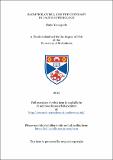Files in this item
Sacrifice, curse, and the covenant in Paul's soteriology
Item metadata
| dc.contributor.advisor | Moffitt, David M. | |
| dc.contributor.author | Yamaguchi, Norio | |
| dc.coverage.spatial | xi, 306 p. | en_US |
| dc.date.accessioned | 2015-09-08T15:15:16Z | |
| dc.date.available | 2015-09-08T15:15:16Z | |
| dc.date.issued | 2015 | |
| dc.identifier.uri | https://hdl.handle.net/10023/7419 | |
| dc.description.abstract | Pauline scholarship often overlooks the fact that from the Levitical sacrificial perspective “sacrifice” and “curse” are diametrically opposed concepts. A sacrifice must be “holy and acceptable to God” (Rom 12:1). Arguably, Paul describes Jesus or his blood as a sacrifice to God (1Cor 5:7; Rom 3:25). In this light, how might we understand his assertion that Christ became a “curse” on the cross (Gal 3:13)? The “accursed” person who hangs on a tree is impure and defiled and thus totally unacceptable as a sacrifice to God (Deut 21:23; John 19:31). This research argues that the key concept that resolves such potential tensions in Paul’s statements is the “covenant”. Both “sacrifice” and “curse” are covenantal concepts. Sacrificial activities are essential for maintaining the covenant between God and his people. When God’s people sin, sacrifice provides the means to attain forgiveness and to remain in the covenant. However, the covenant can be broken by grievous sins such as idolatry, which result in the loss of the sanctuary and the sacrificial means. Consequently, they would fall under the “curse” of the covenant. This covenantal perspective underlies Paul’s soteriology. This thesis demonstrates that in Paul’s understanding Christ’s death serves both ends: the termination of the Mosaic curse by becoming a curse, and the dedication of his life-blood for the maintenance of the renewed covenant. These two things are related yet not identical. As test cases for this covenantal model, this research examines three Pauline texts. Galatians 3:13 describes the redemption of God’s people from the Mosaic covenantal curse. Deutero-Isaiah envisaged this event as a new “Exodus”, about which Paul talks in 1 Corinthians 5:7. Romans 3:25 illustrates the eschatological Yom Kippur for this new Exodus people consisting now of Jews and Gentiles, which sustains and sanctifies God’s renewed covenant people to the end. | en_US |
| dc.language.iso | en | en_US |
| dc.publisher | University of St Andrews | |
| dc.subject.lcc | BS2655.S25Y2 | |
| dc.subject.lcsh | Bible. Epistles of Paul--Theology | en_US |
| dc.subject.lcsh | Salvation--Biblical teaching | en_US |
| dc.subject.lcsh | Sacrifice--Biblical teaching | en_US |
| dc.subject.lcsh | Covenant theology | en_US |
| dc.title | Sacrifice, curse, and the covenant in Paul's soteriology | en_US |
| dc.type | Thesis | en_US |
| dc.type.qualificationlevel | Doctoral | en_US |
| dc.type.qualificationname | PhD Doctor of Philosophy | en_US |
| dc.publisher.institution | The University of St Andrews | en_US |
This item appears in the following Collection(s)
Items in the St Andrews Research Repository are protected by copyright, with all rights reserved, unless otherwise indicated.

